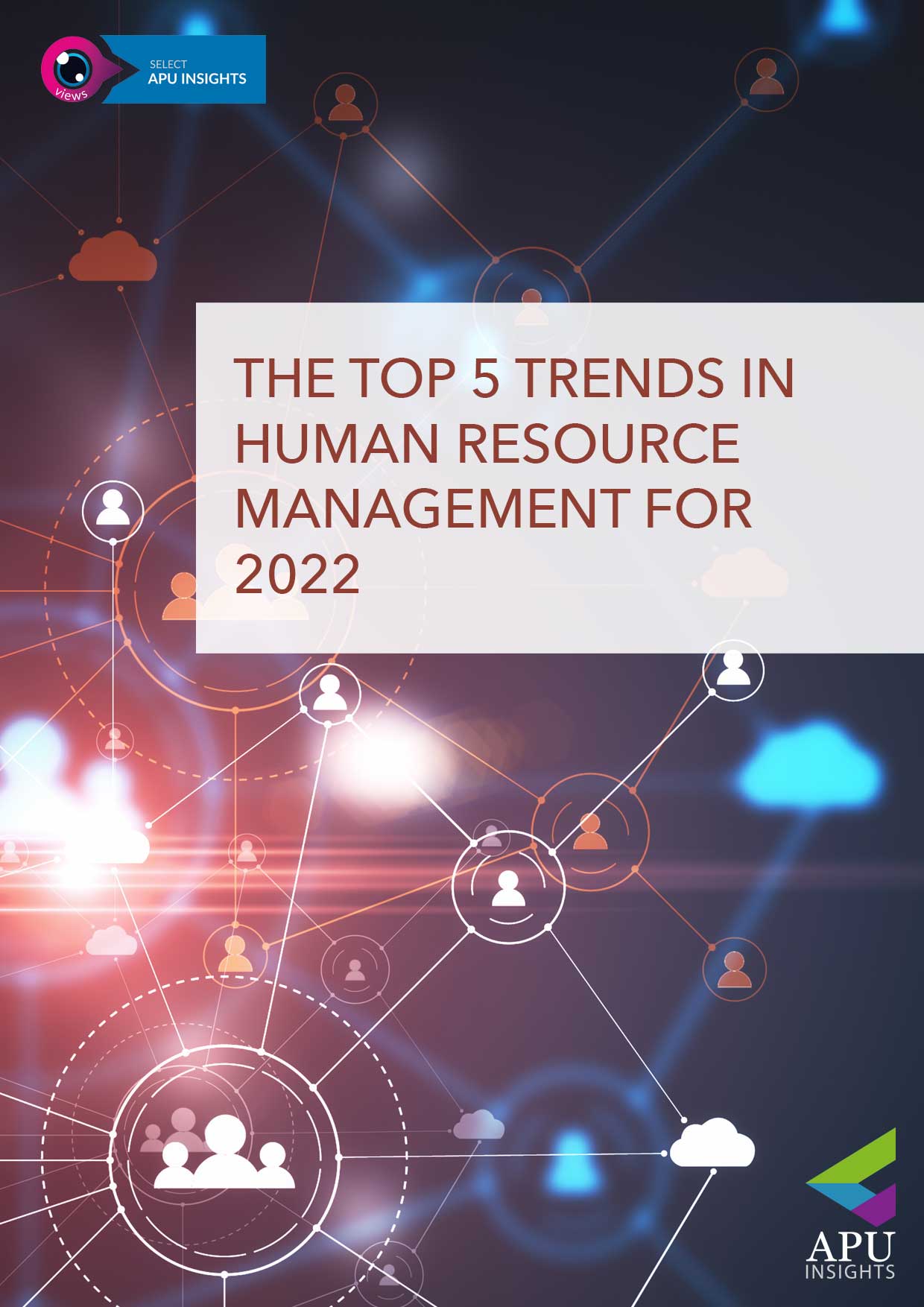The top 5 trends in human resource management for 2022
Dr. Evangelo Damigos; PhD | Head of Digital Futures Research Desk
- Competitive Differentiation
Publication | Update: Nov 2022

In 2021, the global human resource management market size was estimated at USD 19.38 billion and is forecast to grow at a compound annual growth rate (CAGR) of 12.8 percent from 2022 to 2030. The increasing automation and digitization of HR activities to create flexible and efficient pathways is expected to boost the market demand during the forecast period. The development may also depend on the efforts made by companies to attract the appropriate applicant pool, manage resources effectively and retain human capital. These human resource management solutions have the potential to increase and improve workflows at HR, thus driving the market.[1]
1. The Transition from Employee Well-being to Healthy Organization
In recent years, employee mental health and wellbeing have received the attention they deserve in the workplace. In the 2021 sentiment survey by HR, more than 68 percent of senior managers at HR ranked employee wellbeing and mental health as a key priority. Given the shock, frustration and uncertainty that followed the pandemic, the Healthy Organization takes a holistic and more comprehensive approach to wellbeing across the institution. This approach goes beyond the physical health and safety of the workforce and seeks to provide more training and empowerment opportunities. The Healthy Organization framework includes the following elements:
· Physical Health
· Mental Well-being
· Financial Fitness
· Social Health and Community Service
· Safe Workplace
· Healthy Culture
In the face of a deadly pandemic that has affected workers and the workplace, it stands to reason that a Healthy Organization would be a welcome trend to improve productivity and employee satisfaction, leading to higher employee retention.[1]
1. Hybrid Work
Hybrid work will continue to exist in the future. According to the Accenture Future of Work Study 2021, which surveyed more than 9,000 workers from around the world, the majority of respondents want a hybrid work model, where they sometimes work remotely and other times locally. 83 percent of workers prefer a hybrid work style, and 63 percent of high-growth companies have already adopted a "productivity anywhere" model for their employees, according to a survey by Accenture.[2] Gartner surveyed 127 business leaders from HR, legal and compliance, finance and real estate in June 2020 to find out how they envision the workplace after Covid. Even after pandemics, 47 percent of employers will allow their employees to work remotely, the report found. Other companies (43%) will introduce flexible working hours and allow their employees to choose between remote and on-site work.[3]
Figure 2: Company leader intentions regarding flexible working after COVID-19. Gartner, Inc. (2020, July). Gartner survey reveals 82% of company leaders plan to allow employees to work remotely some of the time. Retrieved from: https://www.gartner.com/en/newsroom/press-releases/2020-07-14-gartner-survey-reveals-82-percent-of-company-leaders-plan-to-allow-employees-to-work-remotely-some-of-the-time

The hybrid office is one of the hottest HR trends for 2022 and offers a flexible approach to workplace organization:
· Partially remote means that part of the workforce works remotely while others operate on-site. This is a common situation for companies that cannot move certain functions to the cloud due to security or hardware constraints.
· Flexible remote hours or days that allow employees to manage their workload and spend some of their time remotely.
· An office organization similar to coworking, where employees do not have a designated desk or workspace. Once they have decided to work on site, they reserve workspaces in advance.
Companies are rejecting long-term office leases and investing in spaces that serve as headquarters and prime locations. Hubspot, for example, a provider of sales and marketing tools, has offered its employees three options: @home, @office, and @flex. Starting in January 2022, employees have the option to work mostly from home, commute to the office three or more days a week, or have a mixed work schedule. This programme will reinforce Hubspot's location-independent strategy and promote employee wellness.[1]
1. AI in Employee Management
Artificial intelligence will have a significant impact on talent retention and employee satisfaction in 2022.It will enable HR departments to optimize the overall employee experience and provide more customized training solutions and plans to their employees. The use of AI will help HR 's teams and experts make better decisions to improve the employee experience. In addition, in 2022, HR teams will continue to use AI chatbots to support people management. A new communication channel where employees can discuss HR-related issues, such as payroll, employee benefits and more. They can also complete repetitive tasks in seconds.
2. Corporate Sustainability
More than ever, job seekers are looking for organizations with environmental initiatives. Therefore, companies need to evolve and become more sustainable, not only environmentally, but also socially and ethically. Adopting sustainable practices in the workplace will improve talent retention and brand image, as well as attract more job seekers. Adopting these important HR trends for 2022 will increase a company's attractiveness to customers. Most importantly, knowing that they work for a sustainable company will make its employees happy and motivated.[2]
3. Introduce DEI into the Workplace Culture
The most important trend confronting HR is performative DEI work. Once a knee-jerk reaction to discrimination in the workplace, companies are increasingly paying attention to diversity, equality, inclusion and belonging. DEI is the common thread that runs through companies as they seek to retain current and potential employees for the long term. With companies losing billions in discrimination lawsuits, absenteeism, lost productivity and high turnover rates, they are now willing to spend millions to minimize racial bias and implement strategic plans to promote racial equality and inclusion in the workplace.[1]
[1] Grand View Research, Inc. (n.d.). Human Resource Management Market Size Report, 2030. Retrieved from: https://www.grandviewresearch.com/industry-analysis/human-resource-management-hrm-market
[2] Dixit, R. (n.d.). HR Trends for 2022: Future of Human Resource Management. SelectHub. Retrieved from: https://www.selecthub.com/hris/hr-trends/
[3] Accenture. (2021, April). The future of work: A hybrid work model. Retrieved from: https://www.accenture.com/us-en/insights/consulting/future-work
[4] Gartner, Inc. (2020, July). Gartner survey reveals 82% of company leaders plan to allow employees to work remotely some of the time. Retrieved from: https://www.gartner.com/en/newsroom/press-releases/2020-07-14-gartner-survey-reveals-82-percent-of-company-leaders-plan-to-allow-employees-to-work-remotely-some-of-the-time
[5] Chorna, I. (2022, August). Top 5 HR trends for 2022 and beyond. HRForecast. Retrieved from: https://hrforecast.com/top-5-hr-trends-for-2021-and-beyond/
[6] Factorialblog. (2022, May). Top 11 Emerging HR Trends in 2022 That You Should be Aware Of. Retrieved from: https://factorialhr.co.uk/blog/hr-trends-2022/
 Digital Themes: Competitive Differentiation
Digital Themes: Competitive Differentiation

HTML
 Access Rights | Content Availability:
Access Rights | Content Availability: 


Objectives and Study Scope
This study has assimilated knowledge and insight from business and subject-matter experts, and from a broad spectrum of market initiatives. Building on this research, the objectives of this market research report is to provide actionable intelligence on opportunities alongside the market size of various segments, as well as fact-based information on key factors influencing the market- growth drivers, industry-specific challenges and other critical issues in terms of detailed analysis and impact.
The report in its entirety provides a comprehensive overview of the current global condition, as well as notable opportunities and challenges.
The analysis reflects market size, latest trends, growth drivers, threats, opportunities, as well as key market segments. The study addresses market dynamics in several geographic segments along with market analysis for the current market environment and future scenario over the forecast period.
The report also segments the market into various categories based on the product, end user, application, type, and region.
The report also studies various growth drivers and restraints impacting the market, plus a comprehensive market and vendor landscape in addition to a SWOT analysis of the key players.
This analysis also examines the competitive landscape within each market. Market factors are assessed by examining barriers to entry and market opportunities. Strategies adopted by key players including recent developments, new product launches, merger and acquisitions, and other insightful updates are provided.
Research Process & Methodology

We leverage extensive primary research, our contact database, knowledge of companies and industry relationships, patent and academic journal searches, and Institutes and University associate links to frame a strong visibility in the markets and technologies we cover.
We draw on available data sources and methods to profile developments. We use computerised data mining methods and analytical techniques, including cluster and regression modelling, to identify patterns from publicly available online information on enterprise web sites.
Historical, qualitative and quantitative information is obtained principally from confidential and proprietary sources, professional network, annual reports, investor relationship presentations, and expert interviews, about key factors, such as recent trends in industry performance and identify factors underlying those trends - drivers, restraints, opportunities, and challenges influencing the growth of the market, for both, the supply and demand sides.
In addition to our own desk research, various secondary sources, such as Hoovers, Dun & Bradstreet, Bloomberg BusinessWeek, Statista, are referred to identify key players in the industry, supply chain and market size, percentage shares, splits, and breakdowns into segments and subsegments with respect to individual growth trends, prospects, and contribution to the total market.
Research Portfolio Sources:
Global Business Reviews, Research Papers, Commentary & Strategy Reports
M&A and Risk Management | Regulation

The future outlook “forecast” is based on a set of statistical methods such as regression analysis, industry specific drivers as well as analyst evaluations, as well as analysis of the trends that influence economic outcomes and business decision making.
The Global Economic Model is covering the political environment, the macroeconomic environment, market opportunities, policy towards free enterprise and competition, policy towards foreign investment, foreign trade and exchange controls, taxes,
financing, the labour market and infrastructure.
We aim update our market forecast to include the latest market developments and trends.
Review of independent forecasts for the main macroeconomic variables by the following organizations provide a holistic overview of the range of alternative opinions:
As a result, the reported forecasts derive from different forecasters and may not represent the view of any one forecaster over the whole of the forecast period. These projections provide an indication of what is, in our view most likely to happen, not what it will definitely happen.
Short- and medium-term forecasts are based on a “demand-side” forecasting framework, under the assumption that supply adjusts to meet demand either directly through changes in output or through the depletion of inventories.
Long-term projections rely on a supply-side framework, in which output is determined by the availability of labour and capital equipment and the growth in productivity.
Long-term growth prospects, are impacted by factors including the workforce capabilities, the openness of the economy to trade, the legal framework, fiscal policy, the degree of government regulation.
Direct contribution to GDP
The method for calculating the direct contribution of an industry to GDP, is to measure its ‘gross value added’ (GVA); that is, to calculate the difference between the industry’s total pretax revenue and its total boughtin costs (costs excluding wages and salaries).
Forecasts of GDP growth: GDP = CN+IN+GS+NEX
GDP growth estimates take into account:

Market Quantification
All relevant markets are quantified utilizing revenue figures for the forecast period. The Compound Annual Growth Rate (CAGR) within each segment is used to measure growth and to extrapolate data when figures are not publicly available.
Revenues
Our market segments reflect major categories and subcategories of the global market, followed by an analysis of statistical data covering national spending and international trade relations and patterns. Market values reflect revenues paid by the final customer / end user to vendors and service providers either directly or through distribution channels, excluding VAT. Local currencies are converted to USD using the yearly average exchange rates of local currencies to the USD for the respective year as provided by the IMF World Economic Outlook Database.
Industry Life Cycle Market Phase
Market phase is determined using factors in the Industry Life Cycle model. The adapted market phase definitions are as follows:

The Global Economic Model
The Global Economic Model brings together macroeconomic and sectoral forecasts for quantifying the key relationships.
The model is a hybrid statistical model that uses macroeconomic variables and inter-industry linkages to forecast sectoral output. The model is used to forecast not just output, but prices, wages, employment and investment. The principal variables driving the industry model are the components of final demand, which directly or indirectly determine the demand facing each industry. However, other macroeconomic assumptions — in particular exchange rates, as well as world commodity prices — also enter into the equation, as well as other industry specific factors that have been or are expected to impact.
Forecasts of GDP growth per capita based on these factors can then be combined with demographic projections to give forecasts for overall GDP growth.
Wherever possible, publicly available data from official sources are used for the latest available year. Qualitative indicators are normalised (on the basis of: Normalised x = (x - Min(x)) / (Max(x) - Min(x)) where Min(x) and Max(x) are, the lowest and highest values for any given indicator respectively) and then aggregated across categories to enable an overall comparison. The normalised value is then transformed into a positive number on a scale of 0 to 100. The weighting assigned to each indicator can be changed to reflect different assumptions about their relative importance.

The principal explanatory variable in each industry’s output equation is the Total Demand variable, encompassing exogenous macroeconomic assumptions, consumer spending and investment, and intermediate demand for goods and services by sectors of the economy for use as inputs in the production of their own goods and services.
Elasticities
Elasticity measures the response of one economic variable to a change in another economic variable, whether the good or service is demanded as an input into a final product or whether it is the final product, and provides insight into the proportional impact of different economic actions and policy decisions.
Demand elasticities measure the change in the quantity demanded of a particular good or service as a result of changes to other economic variables, such as its own price, the price of competing or complementary goods and services, income levels, taxes.
Demand elasticities can be influenced by several factors. Each of these factors, along with the specific characteristics of the product, will interact to determine its overall responsiveness of demand to changes in prices and incomes.
The individual characteristics of a good or service will have an impact, but there are also a number of general factors that will typically affect the sensitivity of demand, such as the availability of substitutes, whereby the elasticity is typically higher the greater the number of available substitutes, as consumers can easily switch between different products.
The degree of necessity. Luxury products and habit forming ones, typically have a higher elasticity.
Proportion of the budget consumed by the item. Products that consume a large portion of the
consumer’s budget tend to have greater elasticity.
Elasticities tend to be greater over the long run because consumers have more time to adjust their behaviour.
Finally, if the product or service is an input into a final product then the price elasticity will depend on the price elasticity of the final product, its cost share in the production costs, and the availability of substitutes for that good or service.
Prices
Prices are also forecast using an input-output framework. Input costs have two components; labour costs are driven by wages, while intermediate costs are computed as an input-output weighted aggregate of input sectors’ prices. Employment is a function of output and real sectoral wages, that are forecast as a function of whole economy growth in wages. Investment is forecast as a function of output and aggregate level business investment.




 Industry: Services and Business Services
Industry: Services and Business Services 
